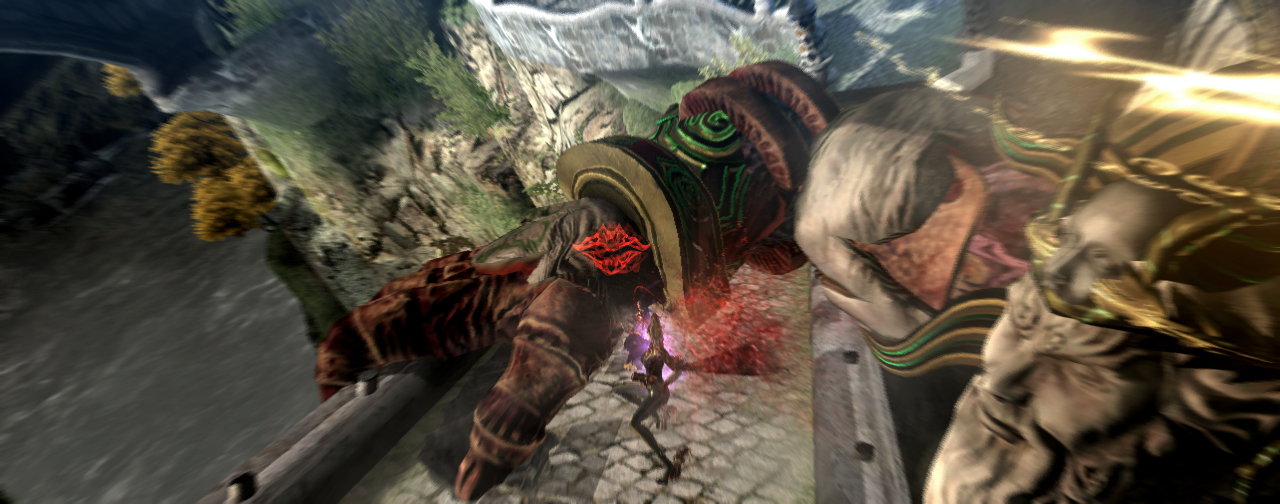Hello, everyone. I’m Washi, background design lead on the Bayonetta team. Pleased to meet you all.
I’ve been working with Kamiya-san since Okami, and I’m incredibly excited to be working on this game everyday.
Anyways, I wanted to make an appearance on the blog and tell you a bit about the background design (stage design) in Bayonetta.
Writing the word background makes it seem like it is all just simple scenery, and calling it a backdrop makes it all sound a bit too boring… Bayonetta, it goes without saying, is an action game. Moreover one that’s even been labeled a ∞ Climax Action game.
In an action game, backgrounds (and sorry if this is a bit obvious) don’t simply function as a tool to express the world the game takes place in, but also are the arenas upon which battles with your enemies play out. This is both the most difficult and most enjoyable aspect of creating stage backgrounds.
When you are fighting the same enemy on a different stage, it’s pretty clear that you end up with a different fight, right? Then if you have stages that change in real time, you should expect the amount of fun to multiply, as well. So what if you had lots of those kinds of stages?
To tell you the truth, when we started working on Bayonetta, the stage design team spent an enormous amount of time using the newly attained expressive power of the so-called “next-gen systems” trying to figure out how much prettier we could make the graphics. The amount of things we had to do had increased drastically from before, leading to repeated trial and error, but eventually development progressed and we were finally able to set our sights on a level of graphics we could accept. However, if we would have stopped there, we would have ended up with nothing more than pretty backgrounds. They’d have been backdrops.
You could say that this is where the real work began for the stage design team.
There are various elements to ∞ Climax Action, and each section within the Bayonetta team carries their own weight and has included numerous ideas into the game. The background team in charge of stage design takes the ideas drawn up by the game director or planners, and then coordinates with each section of the team – the programmers, effect and motion designers, the sound team, etc. – gaining their support in creating the stages while we design. This time, we made an action game filled with a non-stop assault of Climax scenes!!
When I thought about how our users are going to enjoy the game, or be surprised by its content, it was clear that stages with movement were an absolutely fundamental element. If the stages we tried to make at first were to be labeled with the idea of tranquility, these stages were to be about movement.
However, even if you say “stages with movement,” if they end up as simple “moving backgrounds,” they won’t pack the right punch. What becomes important here is the game camera.
Normally, and especially with the things we like to identify as the climax scenes in a film, I think one way they are able to ratchet up the excitement in scenes are with things like incredibly audacious camera work; however, in the case of games, if you go too far you’ll end up in a situation where the player can’t follow the game, and they will feel the camera is a hindrance to the game/battle. And there is no way you could just leave the best parts, the battles, to be played out in a cutscene. That’s just a waste!!
If it can be achieved, we want to fight a real battle inside something that feels like a cutscene!
With that concept in hand, our director and programmers arrived at a wonderful solution to our camera setup, and once it was put into a stage, we were finally able to say that we had completed a “stage with movement.”

As one progresses through a game, the way the game balances out and presents the various forms of “stress and release” is something I believe to be an important point. With Bayonetta’s stage design, we’ve linked this idea of “stress and release” with the concept of tranquility and movement.
The distribution of these moments is something that we are, of course, paying very close attention to as we proceed through production; however, if I had to put a word on what Bayonetta is like, it would have to be thrill ride!
Not to beat a dead horse, but it’s all because the game is a non-stop assault of Climax scenes. ∞ Climax Action! When I pick up the controller to play a stage we have finished, if someone says to me, “This is kind of boring right here,” I respond, “Well, then let me toss in a little bit more of the ol’ Climax!” (Even though I don’t really have time…) That’s kind of how things are in the studio right now.
In any case, Bayonetta is turning out to be pumped full of all sorts of big and small tricks; a full on rush of outrageous stages.
I’m sorry I could give you even more detailed take on the stage design in Bayonetta, but when you are talking about things like this, there is no escaping the fact that you can’t be too detailed or you will venture straight into spoilers. For now, I’m giving my work my all in hopes that it will get the game into your hands even just a day sooner, so look forward to the final product!!